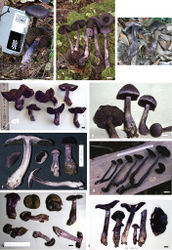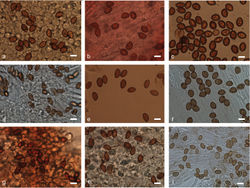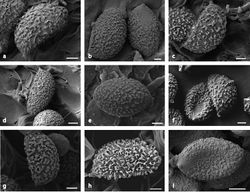Cortinarius neotropicus
| Notice: | This page is derived from the original publication listed below, whose author(s) should always be credited. Further contributors may edit and improve the content of this page and, consequently, need to be credited as well (see page history). Any assessment of factual correctness requires a careful review of the original article as well as of subsequent contributions.
If you are uncertain whether your planned contribution is correct or not, we suggest that you use the associated discussion page instead of editing the page directly. This page should be cited as follows (rationale):
Citation formats to copy and paste
BibTeX: @article{Harrower2015MycoKeys, RIS/ Endnote: TY - JOUR Wikipedia/ Citizendium: <ref name="Harrower2015MycoKeys">{{Citation See also the citation download page at the journal. |
Ordo: Agaricales
Familia: Cortinariaceae
Genus: Cortinarius
Name
Cortinarius neotropicus Harrower sp. nov. – Wikispecies link – Pensoft Profile
Diagnosis
Similar to Cortinarius palatinus Harrower sp. nov. but differs by its longer basidiospores and presence of caulocystidia. Unique molecular synapomorphies are found at pos. 58, 161, 200, 205 (ITS1), 467, 566 (ITS2) in our alignment.
Type
COSTA RICA. San Jose: Perez Zeledon, Villa Mills, CATIE Experimental Forest, 9°33'03"N; 83°40'55"W, 2880 m, (Quercus costaricensis), 22 June 1994, R.E.Halling 7330 (holotype: NY 34729).
Etymology
Refers to where it is found: the neotropics.
Description
Pileus 28–88 mm wide, convex to plano-convex, surface dry, not hygrophanous, squamulose to appressed squamulose, (18D3-6, 18E3-6), dull violet to greyish violet, red with KOH. Lamellae subdistant, adnexed to adnate, average thickness, ventricose, dark violet (17F2). Stipe 61–149 mm long, 4–16 mm thick at apex, 7–48 mm thick at base, tapering gradually from base to apex, sometimes clavate, dry, 18(D–E)(3–6), dull violet to grayish violet. Universal veil pale violet. Basal mycelium white. Odor mild. Taste mild.
Basidiospores (11.5–) 13–17 µm × 7–10 µm, means = 13–15 × 8–9 µm, Q = 1.53–1.77, Q means = 1.59–1.78, (200 spores, 8 specimens), ellipsoid to amygdaloid, finely verrucose, plage present under SEM. Basidia 4-spored, clavate, (25–) 30–45 (–55) µm × 10–15 µm. Cheilocystidia abundant, narrowly fusiform to lageniform, brown or grey in KOH, (40–) 50–75 (–95) µm × (10–) 15–20 (–30) µm. Pleurocystidia abundant, narrowly fusiform to lageniform, sometimes subcapitate, brown or grey in KOH, (35–) 50–90 (–120) µm × 10–25 (–40) µm. Caulocystidia present. Pileipellis a trichoderm, composed of interwoven smooth hyphae, these 9–20 µm wide, 265–415 µm high, multiseptate, with brown contents in KOH, terminal hyphae mostly blunt-ended, some lanceolate. Clamp connections present.
Ecology and distribution
Known from Costa Rica and Colombia. With Quercus copeyensis, Quercus seemannii, and Quercus costaricensis in Costa Rica and with Quercus humboldtii and Trigobalanus in Colombia. 2200–2880 m alt. Fruiting late May to the end of August in Costa Rica and November in Colombia.
Other specimens examined
Colombia. Huila: Finca Merenberg, (Quercus humboldtii), 21 May 1987, R.E.Halling 5284 (NY). Valle del Cauca: Municipio de Pance, Parque Nacional Los Farallones, above El Topacio, (Trigonobalanus), 17 Nov. 1988, A.E.Franco-Molano 151 (NY). Costa Rica. San Jose: Perez Zeledon, Villa Mills, CATIE Experimental Forest, 9°33'03"N 83°40'60 W (Quercus costaricensis), 30 June 1998, R.E.Halling 7787 (NY 75934). Perez Zeledon, Villa Mills, CATIE Experimental Forest, 9°33'03"N; 83°40'60"W, 2840 m, (Quercus costaricensis), 27 June 2000, R.E.Halling 7946 (NY 460484). San Gerardo de Dota, Albergue de Montana, Savegre, ~5 km SW of Cerro de la Muerte, 9°33'02"N; 83°48'27"W, 2200 m alt., (Quercus copeyensis and Quercus seemannii), 9 June 2001, R.E.Halling 8154 (NY 795935). San Gerardo de Dota, Albergue de Montana, Savegre, ~5 km SW of Cerro de la Muerte, 9°33'02"N; 83°48'27"W, 2500 m alt., (Quercus copeyensis and Quercus seemannii), 8 June 1997, R.E.Halling 7709 (NY 181476). La Guaria, 9°35'60"N; 83°58'60"W, 2300 m alt., (Quercus copeyensis and Quercus seemannii), 21 Aug. 1995, A.E.Franco-Molano 1393 (NY).
Discussion
Cortinarius neotropicus sp. nov. was treated as ‘Cortinarius sp. CR1’ in Harrower et al. (2015)[1]. This species can be distinguished from Cortinarius palatinus sp. nov., with which it co-occurs in Costa Rica, by its smaller and finely verrucose basidiospores. In addition, Cortinarius neotropicus sp. nov. and Cortinarius violaceus both have caulocystidia, whereas other species in the Cortinarius violaceus group (such as Cortinarius palatinus sp. nov. and Cortinarius atrotomentosus sp. nov.) do not. Colors of the basal mycelium and context have not been recorded. There are no microscopic characters that can be used to distinguish it from Cortinarius violaceus, and the two species are supported as sister lineages (Fig. 1).
Original Description
- Harrower, E; Bougher, N; Winterbottom, C; Henkel, T; Horak, E; Matheny, P; 2015: New species in Cortinarius section Cortinarius (Agaricales) from the Americas and Australasia MycoKeys, (11): 1-21. doi
Images
|
Other References
- ↑ Harrower E, Bougher N, Henkel T, Horak E, Matheny P (2015) Long-distance dispersal and speciation of Australasian and American species of Cortinarius sect. Cortinarius. Mycologia 107(4): 697–709.



